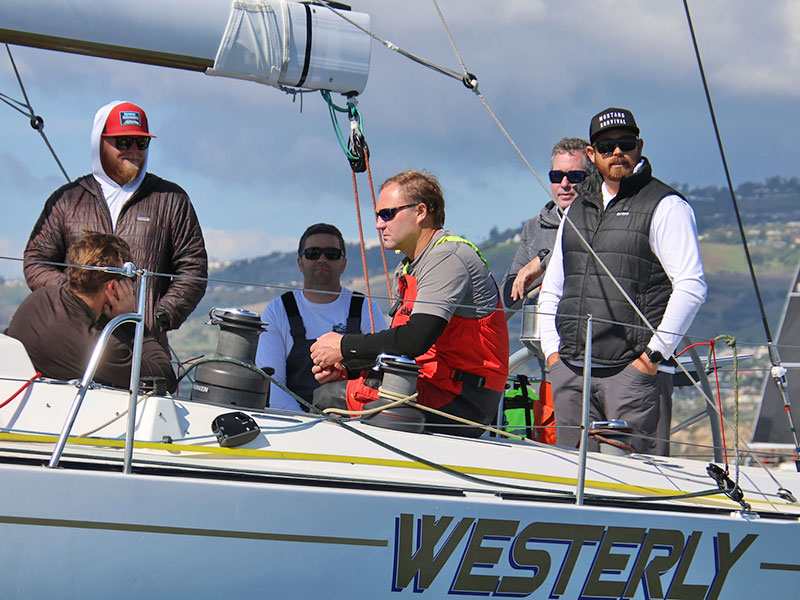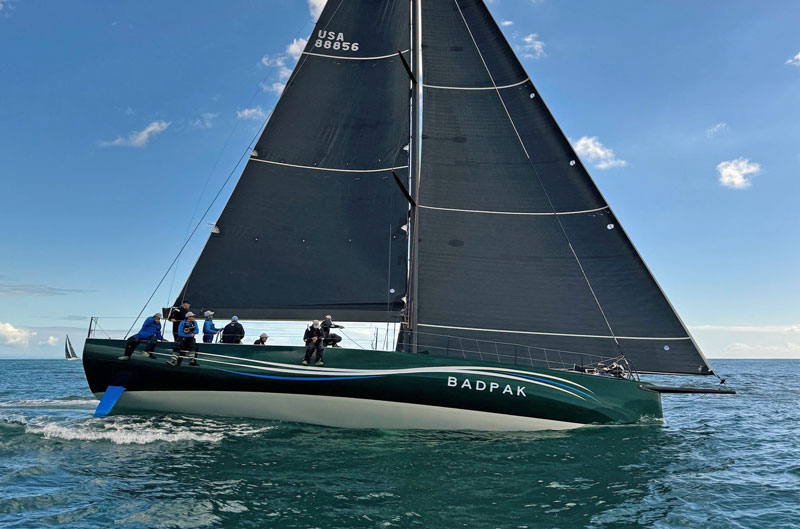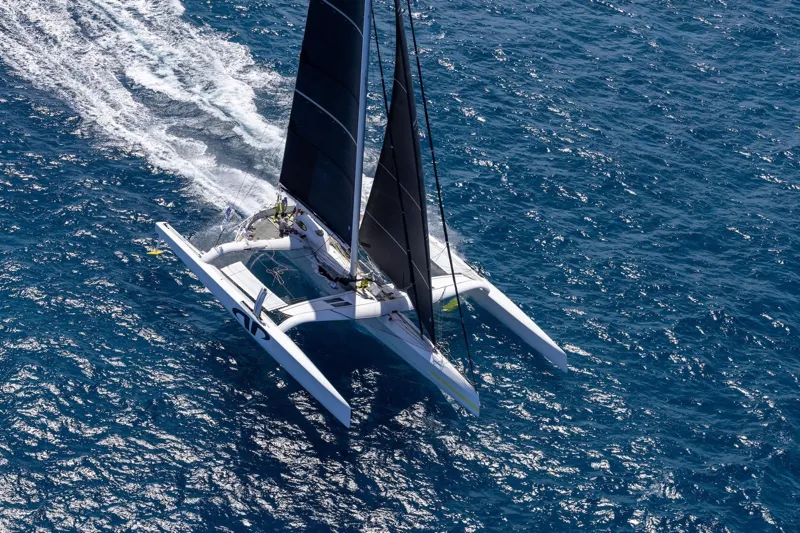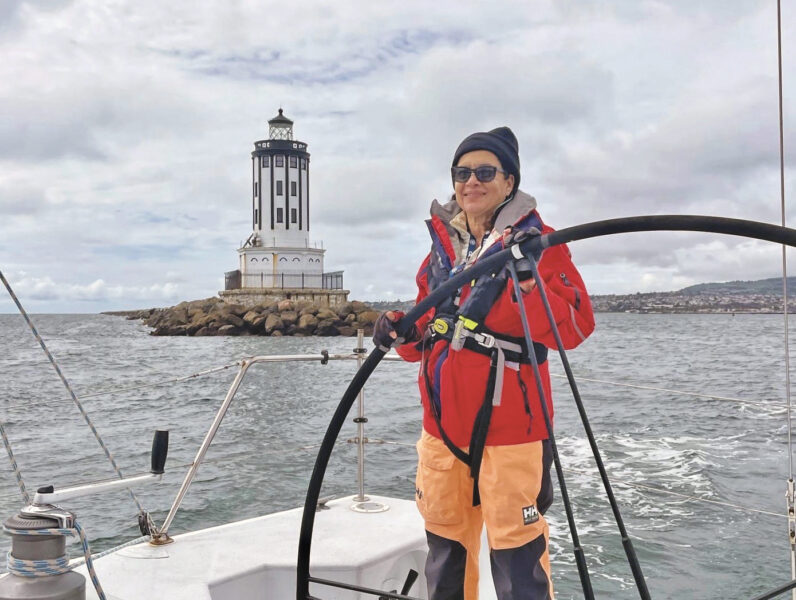
Ashley Perrin and Merf Owen Awarded 2023 Royal Cruising Club Trophy
Ashley Perrin and Merfyn (Merf) Owen, of San Rafael, California, are the recipients of the Cruising Club of America’s Royal Cruising Club Trophy for 2023 for their cruise that circumnavigated Newfoundland by way of Greenland and the Canadian Maritimes. Ashley is a professional Antarctic ice pilot, and Merf is a yacht designer who has passed Cape Horn twice.

The sailors set off from Halifax in 2018 for a three-year adventure. Their first leg was a race — the Route Halifax to Saint-Pierre Ocean Race, which they won in Santana, Ashley’s Capo 30. They then sailed to St. John’s, Newfoundland, for an end-of-season haulout and storage. They also replaced the race gear with cruising gear.
By early spring 2019 they were ready to cast off again and embarked on a five- to six-day passage to Greenland — before the ice had cleared. Thirty miles short of their landfall, the mast sheared off at the deck. It miraculously remained upright due to the internal conduit and their quick action. While they secured the mast, the weather deteriorated and the distance to an anchorage increased. Twelve hours later, in the dark of night with gusts off the ice cap to 70 knots, the anchor was finally set.

When the weather abated they spent 10 days cruising up the inside passage to Nuuk, still with their compromised mast. In Nuuk they hauled and stored Santana. Unbeknown at the time, it would be three winters and two summers before COVID border closures ceased and they could sail back to Canada. They did, however, use this time for repairs.

During summer 2023, Ashley and Merf made a cold, foggy passage to Labrador. Continuing south to Newfoundland, they enjoyed a pleasant cruise along the south coast with its remote anchorages and welcoming “Newfies.” Their three-year cruise had stretched to five years.
Santana was then dry-berthed in St. Peter’s, Bras d’Or Lake, where she awaits further adventures.
The Royal Cruising Club Trophy is awarded to a CCA member and skipper who has undertaken “the most interesting cruise of singular merit and moderate duration.” Contributing to their selection was a detailed article they’d written about their experience in the Club’s publications.
Ashley and Merf have both been guests on our Good Jibes podcast. You can tune in to their stories here:
Good Jibes #22: Ashley Perrin on Navigating Icy Waters and Risky Adventures
Good Jibes #90: Merf Owen on Famous Naval Architecture
What’s on the Sailing Horizon in 2024?
We’re sometimes amazed at all the information available on our own website! Like any sailor in the crow’s nest, we do our best to keep an eye on what’s on the sailing horizon. Our race and calendar editor, Christine Weaver, has done a great job assembling the compilation of fun “things to do” for sailors for years. It shows up in our monthly print publication, online and in our annual Northern California Sailing Calendar. It includes education seminars, sea chanteys, races, cruises, boat shows, rallies and much more. Looking through it we were reminded that Richmond Yacht Club’s next Sail a Small Boat Day is coming up on Saturday, March 2.

The Pacific Cup is running their second seminar this coming weekend at the St. Francis Yacht Club to train participants on provisioning and crew prep. Oakland Yacht Club has a California Boater Safety Card course coming up on March 9. There are two boat shows coming in April, with Svendsen’s Spring Fling April 12-13 and the rejuvenated Newport Beach Boat Show April 18-21. The Singlehanded Sailing Society is running their shorthanded Corinthian Race tomorrow, and Berkeley Yacht Club is having a Crew Party on March 8.

Maybe you’re wondering why your event isn’t in the calendar. It’s possible you sent your event in to [email protected] by the 10th of the month prior to publication, and then we lost it when we accidentally left it in our pocket when we put our clothes in the wash. But if you send your event in by March 10 there’s a pretty good chance it will make our April issue.
To make sure you don’t miss another opportunity to sail, you can pick up a hard copy of the Northern California calendar and magazine at our distribution points here. If you see events but don’t have a boat or don’t have crew, put you name on our Crew List here.
Other times you don’t need a calendar. All you need is a forecast for a warm, sunny Saturday to go sailing. The forecast looks pretty good if you want to get the wrinkles out of your main this weekend.
Vallejo Marina: Gateway to the Bay, Delta, and Napa River
40′ to 45′ foot slips are now available at $9.97/ft. www.ci.vallejo.ca.us
Record-Breaking Pace in Islands Race
The Southern California coastal racing season kicked off with the 2024 Islands Race, co-hosted by Newport Harbor and San Diego Yacht Clubs since 2010. The 142-mile course starts off Point Fermin, rounds Santa Catalina and San Clemente islands, and finishes in San Diego. Twenty-eight boats competed this year on February 9-10.

Conditions for the Start
Would the racers suffer from the atmospheric rivers slamming into SoCal? Much of the heavier-than-usual rainfall had washed out into the ocean. A USCG advisory alerted mariners watch for debris in the water near shore. Competitors spotted lumber, poly rope and lots of plastic. At Friday morning’s start, conditions presented an atypical 4- to 6-knot breeze out of the east. The earlier-starting boats suffered transitioning breeze and an adverse flood current. But by 1 p.m. the westerly had arrived. The ORR A fleet, starting last, enjoyed the best starting conditions — a 5- to 7-knot westerly. Once offshore, the fleet benefited from a cold west-ish breeze.

A New Course Record
Manouch Moshayedi and crew on the Bakewell White Rio100 hoped to overtake the previous monohull course record. (In 2021, Roy P. Disney’s Volvo 70 Pyewacket 70 set an elapsed-time record of 10:49:52.) After turning the last mark to head east toward the finish, Rio100 was on a pace to break the record. The wind held up, and Rio100 sailed to the finish to set a new bar of 10:18:45. The race tracker showed that Rio100 sailed the shortest distance of all competitors (147 miles). “We were very lucky with the weather, which cleared up to a nice sunny day after a few weeks of constant rain and clouds,” commented Moshayedi. “The wind velocity cooperated, and our capable crew did a flawless job to make it possible for us to break the record by 31 minutes.”

Vying for Corrected Time Honors
Meanwhile, Tom Holthus’ Botin 56 BadPak and Roy P. Disney’s Andrews 68 Pyewacket duked it out for the best corrected time. While BadPak took a more southern rounding of the waypoint turning mark, Pyewacket chose the shorter distance. The Santa Cruz 70 Grand Illusion and the J/125 Argo 4 made up time in the last third of the race to jump to the top of the projected standings. But, in the end, BadPak’s time held. They were able to win the Islands Race on corrected time, 18 minutes ahead of Pyewacket and 28 minutes ahead of Grand Illusion. “It was a decent breeze all the way until the finish, where it was light and shifty,” said Holthus. “Behind the islands was magical. We were triple-headed on a reach in 18 knots; the miles went by fast. The air was cold, but the stars were bright.”

“BadPak was in another universe yesterday,” commented Peter Isler, navigator on Pyewacket. “They flew past us before sunset on the outside of the islands with a triple-head rig looking amazing. We had a great competitive race in the sled class. It felt like we were back in the good old days of Southern California offshore racing with five well-sailed, very similar boats tussling for any advantage.”
A Battle Among the Smallest Boats
Competition was close at the other end of the fleet too. With 50 miles to go in Class F, John Staff’s J/111 Obsidian, Greg Nelsen’s Azzura 310 Outsider and Elliott James’s Mancebo 31 Bloom County were within 2 miles of one another in the early morning hours, with the class up for grabs. Bloom County had sailed an excellent first half of the race and was a possible top-five contender until the wind shut down for them. The final 15 miles took several hours. Each boat took a different angle to the finish, with Outsider taking first in class.

“The Islands Race was on the target list this year now that Outsider has a full ORR measurement,” noted Greg Nelsen. “Since Outsider is dry-sailed, it was a much easier delivery to SoCal by trailer than by dodging offshore winter storms. Cabrillo Beach YC graciously hosted us, along with Bloom County, which also made the trek from the San Francisco Bay Area. Dean Wyer, the CBYC marina manager, helped us launch and get our rigs stepped on their very nice two 6-ton hoists.
“Our division started first in very little wind.” Shortly afterward, the race committee postponed the starts for the larger boat divisions. “We crawled toward Catalina, the first mark of the course, at a snail’s pace for the next hour. The wind filled in nicely through the afternoon. We had a tack-free rounding of Catalina and barely got to crack the sheet to lay the first virtual offset mark west of San Clemente, still too close for the code zero in the building breeze offshore. There were a few kelp back-downs, as we do not have a kelp cutter. Finally, abeam of the island, the code zero went up, and we were able to start making some ground, as the Azzura had the shortest waterline in the fleet.
“After the jibe toward San Diego and after passing the last San Clemente offset course virtual mark, we were still reaching with the code, the apparent wind on the beam. The A2 asymmetrical finally got her angle. We had a few hours of running, until, in the wee hours, we hit the transition to shore breeze on the nose with San Diego dead upwind. We got through the transition well and worked the shifts toward the finish, crossing the line in just under 21 hours for a class win by just 2:22 over the J/111, which finished just before us. SDYC is a great place to finish, and with the use of their hoist, the boat was back northbound on Sunday afternoon.” Outsider is signed up for tomorrow’s Singlehanded Sailing Society Corinthian Race.

Where Do We Go From Here?
The Islands Race was held earlier than usual due to its status as a feeder for SDYC’s Puerto Vallarta Race, which had also moved up the calendar to a late February start to take advantage of the full moon, and in collaboration with MEXORC. PV Race starts began yesterday and continue through tomorrow. Twelve teams that sailed in the Islands Race are racing to PV, plus 11 others. We’re looking forward to reports from the PV Race and MEXORC, the latter of which will run March 2-6 out of Marina Vallarta.
The Trade Winds Take a Caribbean Vacation in the RORC 600
When you go to race in the Caribbean there is one thing you can count on — the trade winds. Except when you can’t. This was one of those rare years. The RORC Caribbean 600 took off from English Harbour this past Monday in the normal, breezy trade-wind conditions, though an unusual weather system brought very light air from the north, south, east and west.

It is the 15th edition of the RORC Caribbean 600, which started in glorious conditions off Fort Charlotte, English Harbour, Antigua. Sixty-four boats with over 500 sailors from all over the world took to the start for the nonstop 600-mile race around 11 Caribbean islands.

Not long after the start, the breezes shifted, leaving many boats to battle rare, fluky conditions. It helped to have a big boat with a long waterline, a mast that reaches upper-level breezes, and the ability to generate plenty of apparent wind. The 100-ft Farr Leopard 3 kept the speed on to finish in just over two days, taking line honors in monohulls and the overall win. The 2023 RORC 600 was won by Roy Disney’s Pyewacket, with Ben Mitchell skippering, finishing in one day and 18 hours.

The MOD70s were also able to blast around the 600-mile course. Jason Carroll’s Argo, with former Bay Area resident Charlie Ogletree aboard, took line honors. They finished in one day and eight hours.

Smaller boats weren’t so lucky. Bay Area sailor Nathalie Criou is currently running second in IRC doublehanded aboard her Figaro II Envolée. The light, rotating, nonexistent Caribbean breezes had them rounding Guadeloupe with northerly breezes, causing Guadeloupe to cast a wind shadow to the south. There wasn’t much breeze to even block. As we go to press Envolée has less than 160 miles to go, and the trade winds appear to be reestablishing themselves to help them around the last two marks of Barbuda and Redonda, before heading to the finish at English Harbour.

Despite breezes that ignored the script, it’s still sailing in the Caribbean. The finish off English Harbour did not come easily for many of the finishers, and a number of boats are still battling to get there. We assume the trade winds will get their act together for the St. Maarten Heineken Regatta coming up next week, and the Antigua Classic and Antigua Race Week following in April.
You can follow the rest of the RORC 600 action here.
Keep up with sailing news and stories by subscribing to the 3x weekly ‘Lectronic Latitude here.
‘Good Trouble’ Brings Diversity, Equity and Inclusion to Sailing
In honor of Black History Month, Latitude 38 reached out to SoCal sailor and US Sailing board member Marie Rogers for insights into her nonprofit program Offshore Racing Outreach (ORO), as well as other sailing community leaders. ORO’s Andrews 56 Good Trouble completed the 2023 Transpac, finishing fifth in its class and without injuries or major breakdowns in 11 days between L.A. and Hawaii.
Good Trouble’s crew comprised mostly people of color, including five women in a nine-person crew. Offshore Racing Outreach’s core mission is to recruit and train individuals in the sport of big boat offshore sailboat racing. It’s a program that’s one of a kind, not only on the West Coast, but probably across the country. (Good Trouble is an homage to the late congressman and civil rights activist John Lewis: “Get in good trouble, necessary trouble, and redeem the soul of America.”)

Marie Rogers, the skipper of the boat and a former commodore of the Los Angeles Yacht Club, described herself as “ecstatic” over the results.
“We set out to achieve this goal and we were successful,” Marie said. “We could not have foreseen the challenges that came along the way, and they were significant. Each time we met them head-on, worked it out, and got the ball rolling again. I feel like I grew as a person and a leader. It was definitely a humbling experience.”
Rogers, who is Black and vice president of US Sailing, said she had worked on the project for more than a year and a half.
“We were able to expose a new crop of talented sailors to the offshore world. Among many things, they learned how to navigate, how to troubleshoot systems, how to stay nourished, handle stress and lack of sleep, and what it takes to pace themselves mentally and physically in this serious endurance sport.”
Yosh Han, one of Good Trouble’s crew, said that while the race wasn’t her first sailboat passage to Hawaii, it was definitely different.
“Racing 24/7 was a new experience for me and it felt very different than doing a passage or delivery — mainly, the hand-steering around the clock,” she said. “The night watches and living aboard are similar, but the exhaustion is more apparent with the hand-steering. This trip was colder and upwind longer than expected, but once we cracked off to a reach and downwind with warmer weather, it felt fantastic to be out on the Pacific Ocean. The water is so blue. Sailing under the full moon and the Milky Way is a privilege. So few people get to experience it. When I’m back on shore, I dream of being at sea.”

Han said she felt fortunate to be part of the Good Trouble program. “It’s an incredible opportunity that hasn’t been available to me through my sailing community. While I’ve done many ocean passages and deliveries as well as day races, I hadn’t had the chance to do many offshore races.”
She added that “it’s critical to represent the global majority on the water. So often, people of color in the marine industry are in hospitality or service positions. In performance racing, it’s been mostly homogenous and monoculture. Offshore Racing Outreach has the potential to turn day sailors into offshore racers. It’s a unique opportunity to raise the sport at large. We see many athletes of color in other sports but the yachting industry hasn’t caught up yet. There’s the potential to elevate racers in the program to sail on Good Trouble but also graduate, so to speak, and race on other performance teams.”
Continue reading in the February issue of Latitude 38.
Read about a 2023 study on diversity and inclusion in collegiate sailing here.
Tune in to a recent Good Jibes podcast with Marie Rogers, talking about the DEI Gap in Sailing


